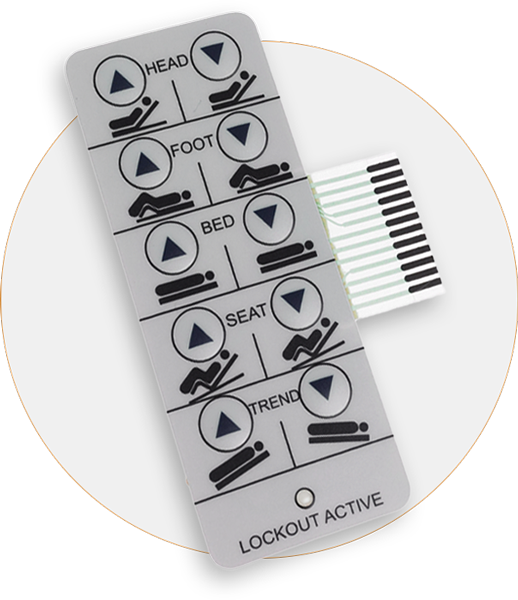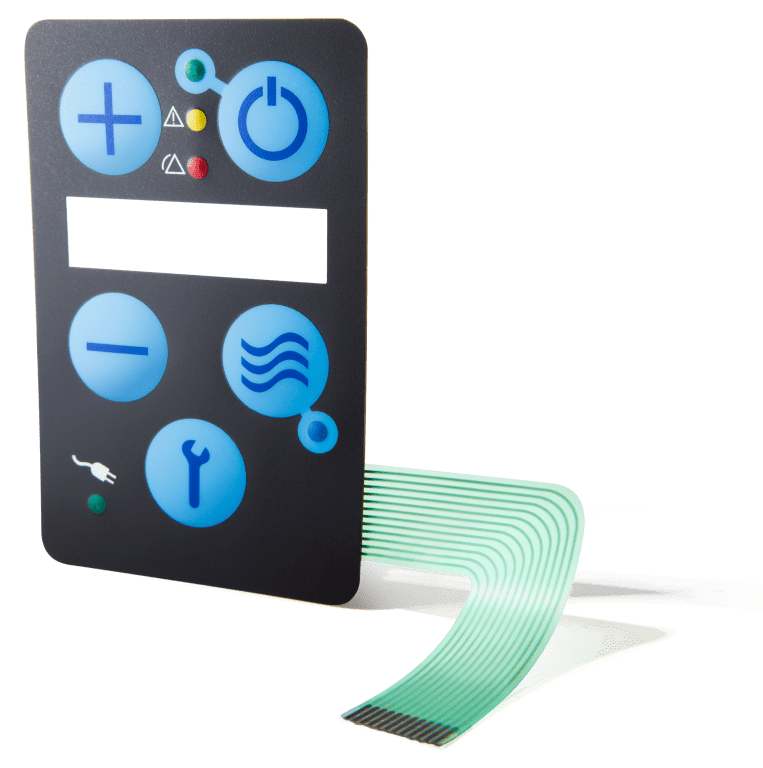Membrane Switch Manufacturer with Quick Prototyping and Lead Time
Checking Out the Manufacturing Process of Membrane Switch for Numerous Industries
The production procedure of Membrane switches is a complex endeavor that requires accuracy and focus to detail. From selecting ideal materials to implementing strenuous quality assurance actions, each action plays an essential duty in making sure performance. Different markets, including vehicle and clinical, depend on these components for their distinct applications. Understanding the details of this procedure discloses considerable insights right into exactly how these buttons are produced and their impact across diverse sectors.
Comprehending Membrane Changes: An Introduction

Trick Products Made Use Of in Membrane Switch Manufacturing
In Membrane switch manufacturing, the choice of key materials greatly affects capability and toughness. Conductive materials, adhesives, and coatings play crucial roles, while substratum choice influences general performance and integrity. Comprehending these elements is necessary for maximizing the design and manufacturing of Membrane buttons.
Conductive Products Review
Conductive materials play a vital function in the performance of Membrane buttons, making certain trusted electric links within the device. Generally made use of materials consist of silver, copper, and carbon-based inks, each offering unique benefits. Silver is favored for its high conductivity and toughness, making it ideal for applications requiring durable efficiency. Copper, while a little less conductive than silver, is a cost-efficient choice typically made use of in published circuits. Carbon-based inks provide a versatile choice, suitable for applications where versatility and reduced prices are focused on, although they have actually lower conductivity contrasted to metal alternatives. The choice of conductive materials straight influences the general integrity, life-span, and efficiency of the Membrane switch, making it a crucial factor to consider in the manufacturing procedure.
Adhesives and Coatings
Coverings and adhesives are necessary parts in the production of Membrane switches, offering crucial bonding and protective buildings. These materials ensure that numerous layers of the switch, including visuals overlays and wiring, adhere firmly to one an additional, enhancing durability and functionality. Typically made use of adhesives include pressure-sensitive adhesives (PSAs) and epoxy-based formulas, which provide strong attachment and strength. Coatings, such as polyurethane or acrylic, offer to shield versus ecological elements, consisting of dampness, abrasion, and chemicals. In addition, finishes can enhance tactile responses and visual allure, adding to the overall customer experience. The option of ideal adhesives and finishings is important for optimizing efficiency and long life in diverse applications throughout different sectors, guaranteeing that Membrane switches over fulfill specific operational demands.
Substratum Selection Elements
Substratum option plays an essential role in the production of Membrane switches, as it greatly influences their general performance and toughness. Secret products such as polyester, polycarbonate, and versatile printed motherboard (FPCBs) are typically made use of for their distinctive residential properties. Polyester is preferred for its cost-effectiveness and resistance to abrasion, making it appropriate for applications with high wear. Polycarbonate deals superior quality and impact resistance, perfect for environments requiring high exposure. FPCBs supply enhanced adaptability and are typically utilized in complex layouts. The option of substrate also affects variables like thermal stability, chemical resistance, and ease of printing. Eventually, choosing the ideal substrate is important for guaranteeing the capability and durability of Membrane changes throughout various sectors.
The Layout Process of Membrane Switches Over
The design procedure of Membrane switches is an essential phase that greatly influences the performance and appearances of the end product - membrane switch manufacturer. It starts with defining the certain requirements of the application, including measurements, switch design, and tactile responses choices. Designers have to consider individual interaction, making sure that the button is intuitive and accessible.Next, materials are chosen based upon durability, flexibility, and environmental resistance. The assimilation of graphics and branding elements is additionally important, as it improves aesthetic allure and interaction. Prototyping enables repetitive testing, enabling modifications based on customer feedback and efficiency evaluations.Additionally, the style needs to represent the electric elements, such as circuits and adapters, making sure integrity and ease of use. Ultimately, an effective layout harmonizes performance, appearances, and customer experience, leading the way for effective manufacturing and resilient performance in various markets
Printing Techniques for Membrane Changes
The printing methods made use of in Membrane button production play a necessary function in figuring out the final item's high quality and performance. Screen printing supplies advantages such as toughness and vibrant color application, while digital printing technologies provide flexibility and precision in style. Understanding these methods can substantially influence the general efficiency of Membrane switches in numerous applications.
Screen Printing Advantages
Many advantages make screen publishing a favored strategy for producing Membrane switches. This method enables premium, vivid shades and in-depth designs, which are crucial for interface applications. Screen printing is especially efficient for using thick ink layers, improving longevity and tactile responses. In addition, it provides exceptional adhesion to different substrates, ensuring long life in requiring settings. The procedure is economical for huge manufacturing runs, as it lessens setup time and waste. In addition, screen printing supports a large range of inks, consisting of specialty and UV-curable choices, enabling versatility in style. Its capacity to create consistent outcomes throughout several devices makes it a trusted selection for suppliers aiming for top quality and effectiveness in Membrane button manufacturing.
Digital Printing Innovations

Improvements in digital printing modern technology are changing the manufacturing of Membrane switches, supplying suppliers innovative solutions that boost design adaptability and efficiency. Digital printing enables intricate styles and high-resolution graphics, enabling custom-made branding and functionality without the constraints of typical approaches. This strategy decreases configuration times and prices, facilitating shorter manufacturing runs and minimal waste, making it perfect for organizations with varying demands. Additionally, innovations in ink solutions provide far better durability and bond, ensuring durability in different environments. As markets increasingly seek tailored and complicated layouts, digital printing stands apart as an important method, establishing a brand-new criterion in Membrane button production. The integration of these developments settings suppliers to meet progressing market needs successfully.
Assembly and Layering of Membrane Switch Components
Mindful assembly and layering of Membrane switch elements are vital to guaranteeing capability and toughness. This procedure starts with the precise alignment of various layers, including the graphic overlay, adhesive, circuit layer, and backing product. Each part must be very carefully placed to preserve electric integrity and individual interface responsiveness.During setting up, conductive traces are put on the circuit layer, normally made from materials like polyester or polycarbonate. This layer is crucial, as it beams when pressure is used. The sticky made use of for bonding these layers is likewise chosen for its ability to endure ecological stresses while keeping a safe and secure bond.Heat and pressure are usually used during the setting up process to determine that the layers stick appropriately without compromising the capability of the button. Focus is given to the side securing to safeguard against dampness and contaminants, protecting the longevity of the Membrane button in various industrial applications.
Quality Assurance Steps in Membrane Switch Production
Quality assurance steps play an important duty in guaranteeing the integrity and efficiency of Membrane switches over adhering to the setting up and layering of their components. In the manufacturing process, numerous key examinations are performed to copyright quality standards. These consist of visual examinations for defects check it out in printing and glue explanation application, as well as functional examinations to validate the responsiveness of each switch.Additionally, ecological screening is done to analyze the buttons' toughness against temperature level variations and moisture direct exposure. Producers commonly apply analytical process control (copyright) techniques to keep track of manufacturing uniformity, enabling very early discovery of anomalies.Furthermore, traceability systems are established to track products and elements, ensuring responsibility and assisting in recalls if essential. Calibration of tools and adherence to market criteria are likewise important to maintaining product integrity. Collectively, these high quality control steps secure the efficiency of Membrane changes throughout various applications, inevitably enhancing consumer complete satisfaction.
Applications of Membrane Switches Across Different Industries
Membrane switches are used throughout a diverse array of markets, showcasing their versatility and adaptability. In the clinical industry, they supply dependable and water resistant user interfaces for gadgets such as analysis tools and mixture pumps, ensuring hygiene and simplicity of use. The vehicle sector employs Membrane switches for dashboard controls, allowing smooth interaction between the vehicle driver and lorry systems.In consumer electronic devices, these switches are discovered in home appliances and handheld tools, supplying a sleek, contemporary aesthetic while enhancing performance. Industrial applications additionally leverage Membrane changes for machinery control panels, where durability and resistance to extreme problems are essential.Furthermore, the aerospace and defense industries make use of Membrane buttons for cockpit instrumentation and interaction systems, focusing on dependability and efficiency under extreme conditions. Generally, Membrane buttons play an essential function in boosting the customer experience and functional efficiency throughout different domains.
Regularly Asked Questions
For how long Does It Require To Produce a Membrane Switch?
The production time for a membrane button typically varies from a couple of days to numerous weeks - membrane switch manufacturer. Elements influencing this period consist of layout intricacy, material schedule, and production quantity, all influencing the general timeline noticeably
What Is the Regular Life-span of a Membrane Layer Switch?
The common life-span of a membrane switch typically varies from 1 to 5 million actuations, depending upon variables such as worldly high quality, ecological problems, and usage regularity, greatly affecting longevity and overall performance.
Can Membrane Switches Be Personalized for Specific Applications?
Membrane buttons can indeed be personalized for particular applications. Their style flexibility allows for changes in dimension, form, shades, and graphics, guaranteeing compatibility with unique needs across different industries and improving functionality and customer experience.

Are Membrane Switches Eco-friendly?
The ecological influence of Membrane switches varies. Some materials used might not be eco-friendly, while developments in producing procedures are increasingly concentrating on sustainability, intending to lower waste and promote recyclable components in their manufacturing.
What Are the Usual Failing Modes of Membrane Buttons?
Common failing settings of Membrane switches include delamination, adhesive failure, deterioration from use, dampness access, and electric failings. These concerns can considerably affect performance, performance, and visit homepage life expectancy in numerous applications throughout various sectors. Membrane buttons can be tailored to fit details style requirements, such as functionality, form, and size, making them highly adaptable.The building and construction usually involves numerous layers, consisting of a visuals overlay, adhesive, and a circuit layer, which function with each other to produce a seamless individual experience. In Membrane button production, the selection of vital products considerably influences capability and sturdiness. The automobile industry uses Membrane switches for dashboard controls, enabling smooth communication in between the driver and automobile systems.In consumer electronics, these switches are located in devices and handheld tools, supplying a streamlined, modern aesthetic while boosting performance. Industrial applications also leverage Membrane switches over for equipment control panels, where durability and resistance to rough conditions are essential.Furthermore, the aerospace and defense industries make use of Membrane switches for cabin instrumentation and communication systems, focusing on integrity and efficiency under severe conditions. Membrane buttons can undoubtedly be customized for specific applications.